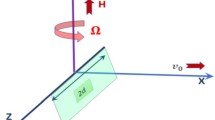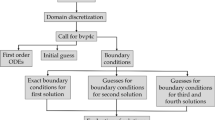Abstract
In this paper, we propose a heat jet approach for atomic simulations at finite temperature of a triangular lattice. First we design a matching boundary condition by carefully examining a residual function based on the lattice dispersion relation. It leads to a two-way boundary condition, where prescribed incoming waves are included with a source term. Meanwhile, we adopt a phonon representation to determine Fourier mode amplitudes. The heat jet approach is then formulated by combining the two-way boundary condition and the phonon representation of heat source. Numerical tests of a tube-shaped computational domain illustrate the accuracy and effectiveness in simultaneously resolving thermal fluctuations and non-thermal motion at a given temperature.



















Similar content being viewed by others
References
Zwanzig R (2001) Nonequilibrium Statistical Mechanics. Oxford University Press, Oxford
Anderson HC (1980) Molecular dynamics simulation at constant pressure and/or temperature. J Chem Phys 72:2384–2393
Berendsen HJC, Postma JPM, van Gunsteren WF, DiHola A, Haak JR (1984) Molecular dynamics with coupling to an external bath. J Chem Phys 81:3684–3690
Bussi G, Parrinello M (2007) Accurate sampling using Langevin dynamics. Phys Rev E 75:056707
Nosé S (1984) A unified formulation of the constant temperature molecular dynamics methods. J Chem Phys 81:511–519
Hoover WG (1985) Canonical dynamics: equilibrium phase-space distributions. Phys Rev A 31:1695–1697
Lepri S, Livi R, Politi A (2003) Thermal conduction in classical low-dimensional lattices. Phys Rep 377:1–80
Xiong D, Zhang Y, Zhao H (2014) Temperature dependence of heat conduction in the Fermi–Pasta–Ulam–beta lattice with next-nearest-neighbor coupling. Phys Rev E 90:022117
Sun T, Wang J, Kang W (2014) Heat transfer in heterogeneous nanostructures can be described by a simple chain model. Phys Chem Chem Phys 16:16914–16918
Zhang C, Kang W, Wang J (2016) Thermal conductance of one-dimensional materials calculated with typical lattice models. Phys Rev E 94:052131
Ai B, Hu B (2011) Heat conduction in deformable Frenkel-Kontorova lattices: thermal conductivity and negative differential thermal resistance. Phys Rev E 83:011131
Sun T, Wang J, Kang W (2013) Van der Waals interaction-tuned heat transfer in nanostructures. Nanoscale 5:128–133
Giardiná C, Livi R, Politi A, Vassalli M (2000) Finite thermal conductivity in 1D lattices. Phys Rev Lett 84:2144–2147
Fu W, Jin T, He D, Qu S (2015) Effect of dynamical localization on negative differential thermal resistance. Phys A 433:211–217
Zhong Y, Zhang Y, Wang J, Zhao H (2012) Normal heat conduction in one-dimensional momentum conserving lattices with asymmetric interactions. Phys Rev E 85:060102
Savin AV, Kosevich YA (2014) Thermal conductivity of molecular chains with asymmetric potentials of pair interactions. Phys Rev E 89:032102
Yang L, Grassberger P, Hu B (2006) Dimensional crossover of heat conduction in low dimensions. Phys Rev E 74:062101
Wang L, Hu B, Li B (2012) Logarithmic divergent thermal conductivity in two-dimensional nonlinear lattices. Phys Rev E 86:040101
Lippi A, Livi R (2000) Heat conduction in two-dimensional nonlinear lattices. J Stat Phys 100:1147–1172
Barik D (2006) Heat conduction in 2D harmonic lattices with on-site potential. Europhys Lett 75:42–48
Xiong D, Wang J, Zhang Y, Zhao H (2010) Heat conduction in two-dimensional disk models. Phys Rev E 82:030101
Karpov EG, Park HS, Liu WK (2007) A phonon heat bath approach for the atomistic and multiscale simulation of solids. Int J Numer Methods Eng 70:351–378
Tang S, Liu B (2015) Heat jet approach for atomic simulations at finite temperature. Commun Comput Phys 18:1445–1460
Tang S, Liu B (2016) Heat jet approach for finite temperature atomic simulation of two-dimensinal square lattice. Multisc Multiphys Mech 1:201–224
Wang X, Tang S (2013) Matching boundary conditions for lattice dynamics. Int J Numer Methods Eng 93:1255–1285
Tang S, Fang M (2010) Unstable surface modes in finite chain computations: deficiency of reflection coefficient approach. Commun Comput Phys 8:143–158
Tang S (2010) A two-way interfacial condition for lattice simulations. Adv Appl Math Mech 2:45–55
Born M, Huang K (1954) Dynamical Theory of Crystal Lattices. Oxford University Press, Oxford
Wang X (2010) Matching boundary conditions for atomic simulations of crystalline solids. PhD thesis, Tsinghua University, Beijing
Li S, Sheng N, Liu X (2008) A non-equilibrium multiscale simulation paradigm. Chem Phys Lett 451:293C300
Liu WK, Qian D, Gonella S, Li S, Chen W, Chirputkar S (2010) Multiscale methods for mechanical science of complex materials: Bridging from quantum to stochastic multiresolution continuum. Int J Numer Methods Eng 83:1039–1080
Acknowledgements
This research is partially supported by NSFC under grant No.s 11521202 and 11272009, and the key subject Computational Solid Mechanics of CAEP. We would like to thank Prof. Hong Zhao, Prof. Dong Qian, Prof. Shaofan Li and the anonymous referees for stimulating discussions.
Author information
Authors and Affiliations
Corresponding author
Appendices
Appendix 1
In designing matching boundary conditions, the selection of involved atoms is crucial. The choice in this study is made after many tries, in addition to the experiences we gained through the study of other lattices. In the following, we choose two different ways with the same number of atoms as in (8).
First, we choose more atoms in the horizontal direction as shown in Fig. 18. The boundary condition reads
with
In Fig. 19, we observe a reflection coefficient much larger than that for (8). This boundary condition performs reasonably well for oblique waves (e.g. in the direction \(\pm \pi /6\)), however, it can not suppress reflection as well for waves with large wave numbers, even at normal incidence.
If instead we choose more atoms in the vertical direction as shown in Fig. 20. The boundary condition reads
with
The reflection coefficient is displayed in Fig. 21. For an oblique incident wave with large angle, it appears to be unstable with the reflection coefficient modulus bigger than 1.
We remark that in case of inputs from all boundaries, both choices require special treatment for more corner atoms, whose involved atoms go out of the lattice under simulation.
From these comparisons, it is clear that the choice of boundary atoms in Fig. 3 is appropriate, with which the boundary condition (8) well treats both normal incidence with large wave numbers, and large angle incidence.
Appendix 2
The heat jet approach applies to weakly nonlinear lattices. This has been demonstrated in [23] for a one-dimensional chain with Morse potential. Here we present one more example, which models dislocation motion at finite temperature.
Similar to [30, 31], we use the Frenkel-Kontorova potential
Here, \(x_i=u_i+a i\) is the position of i-th atom, and \(u_i\) is its displacement away from equilibrium.
The dimensionless governing equation is
Following [30], the characteristic mass, length and time are chosen as \(m_c=26.98amu\), \(L_c=3.253A\) and \(t_c=2 \times 10^{-13}s\), respectively. The elastic constants are \(k_1=1\) and \(k_2=0.7\). We rescale temperature by \(k_B t_c^2/m_c L_c^2\). The phonon heat source temperature 200K hence gives \(T_L=T_R=0.0232\). A constant force \(f=0.03\) is applied to each atom. See Fig. 22 and Fig. 23, the dislocation moves from right to left. The amplitudes near the dislocation becomes larger due to the reflection of incident wave reaching at the dislocation. The instantaneous temperature forms a gradient near dislocation. The results are comparable to those by MS-NEMD simulation (Fig. 3 and Fig. 4 in [30]). We remark that we do not perform multiscale decomposition for the motion.
This example shows that the heat jet approach can be applied to non-equilibrium MD to simulate a dislocation in a nonlinear chain.
Rights and permissions
About this article
Cite this article
Liu, B., Tang, S. & Chen, J. Heat jet approach for finite temperature atomic simulations of triangular lattice. Comput Mech 59, 843–859 (2017). https://doi.org/10.1007/s00466-017-1376-5
Received:
Accepted:
Published:
Issue Date:
DOI: https://doi.org/10.1007/s00466-017-1376-5








